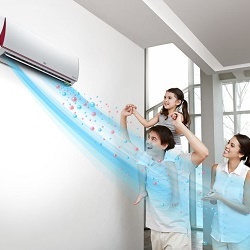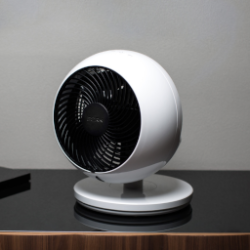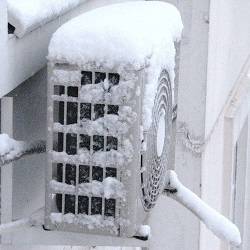How does the air conditioner or split system
Air conditioners and split-systems of various models have already firmly entered the life of a modern person - today, this home appliance is not considered a luxury, as it was in the recent past. These products are specifically designed to create a favorable microclimate inside the buildings in the hot summer, but many models can heat the rooms in the off-season. Fundamentally, the air conditioner device is similar to the layout of individual units of split-systems, the only difference is that the first, as a rule, have one body, and the second - two blocks. The principle of operation of a split system is similar to the operation of a standard household window or floor air conditioner.
Content
Design
How an air conditioner works is quite simple to understand; you just need to examine separately the component parts of an air conditioner: the internal and external units.
Remote unit
The design of the outdoor unit is very complicated, because it controls the operation of the entire system, based on the specified modes, which are manually typed by the user. Its components are presented in the photo:
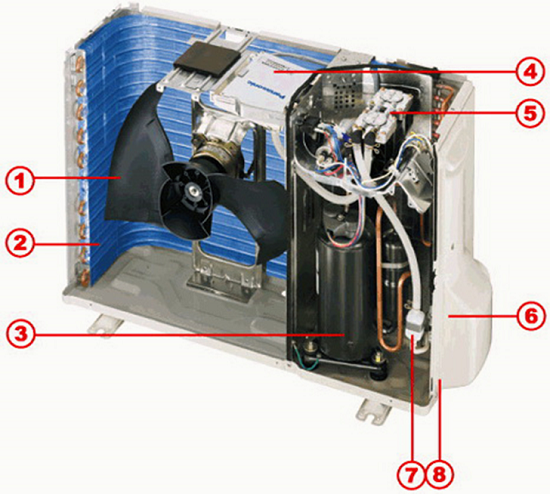
- Fan - his duties to create airflow of internal parts.
- RadiatorIn which the refrigerant is cooled, is called a condenser, it gives off heat to the flow of outside air.
- Compressor the air conditioner compresses the refrigerant and circulates it between the units. Description of the principle of the compressor is easy to find on the Internet, so we will not overload the article with unnecessary technical details.
- Automatic control fee has such an arrangement on models of the inverter class, the rest - all the electronics is located inside the indoor unit of the air conditioner.
- Complicated designs valve it is installed only on models of the “cold-heat” class, when the heating mode is turned on, the principle of operation of the blocks changes in the mirror.
- Capprotecting nipples.
- Filter - protects the device from the ingress of foreign particles that could penetrate the system during installation of the product.
- Outer casing.
Evaporator housing
Its design is not particularly complex.
- Lattice from durable plastic - through it the air enters the device, if necessary, it is possible, opening access to all parts.
- Mesh or filter - its main task is to retain large particles of dust that are in suspension. Experts advise cleaning it several times a month.
- Heat exchanger or evaporator - it cools the air flow before entering the room.
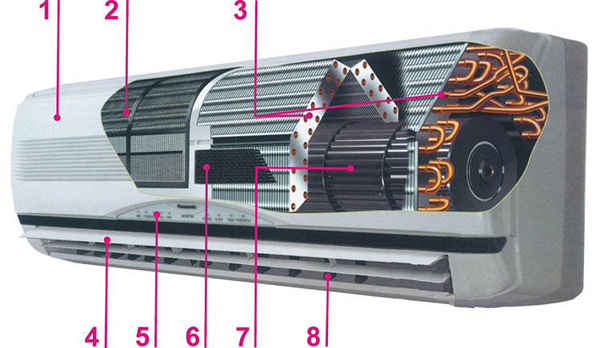
- Horizontal blinds, regulate the direction of the air flow. The position is regulated in two ways: manually or set the oscillatory motion in automatic mode, then the flow of cooled air is evenly distributed throughout the room.
- Indicator panel, showing the modes of operation of the product, the indicators signal all faults when the operation of the air conditioner becomes incorrect.
- Fine cleaning system, which consists of a carbon filter to remove various odors, a device for filtering fine dust, antibacterial and others.
- Fan tangential class - it contributes to the constant circulation of air masses in thisindoors.
- Vertical Blinds - regulate the flow of air on the horizon.
The microprocessor and the electronics board, as well as the connections to which copper circuits with circulating freon are connected, are not shown in the photo - they are located at the back.
The basic design of the air conditioner is virtually unchanged - different models have specific improvements, but the remote and indoor unit are always present.
Now you know what the air conditioner is made of, so you can go on to get a brief introduction to the principle of the specific operation of the air conditioner.
Functional nuances
Liquid substances evaporate when heated, actively absorbing heat from the surface on which they are located, and when condensation occurs, the reverse process occurs - this is the basis of the principle of operation of any air conditioning system. These products cannot produce cold, but only transfer heat from the cooled object to the street or vice versa, which occurs when the heating mode is turned on. Heat is energy, and it cannot disappear without a trace or arise from nowhere, its main carrier in air conditioners is a refrigerant.
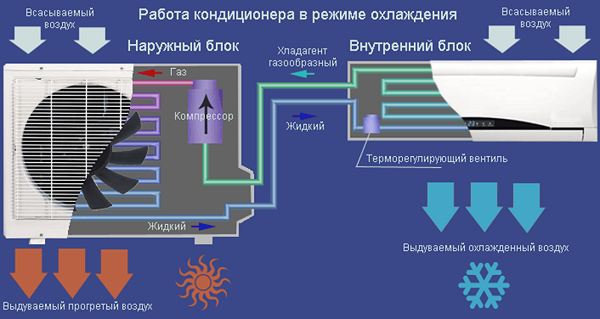
During cooling freon evaporates, its condensation occurs in the remote unit, after the refrigerant compressed to a certain consistency leaves the compressor. If the operation of the air conditioner or split-system is set to heat the room, then everything happens the other way around.
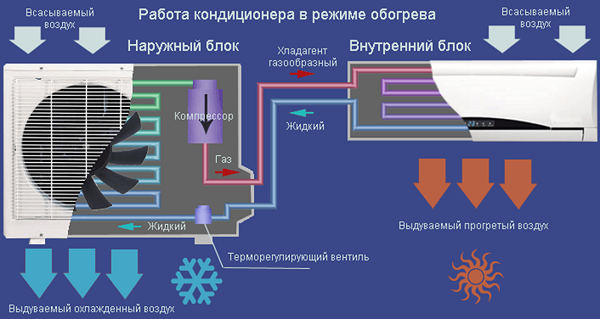
The power supply of the product comes from the electrical network, and users should know that using such devices to heat the room is quite advantageous: by consuming 1 kW of electricity, they transfer 3 kW of thermal energy to the building and do not overdry air.
Technical characteristics of household air conditioners are made up of rated power of the productwhich is spent on cooling or heating of internal rooms. Such design products are used in the offseason, but only at temperatures above zero - they can not be included in the cold. Moreover, the heating occurs according to a special scheme: the floor is heated, creating a comfortable atmosphere for the legs.

Next, there is the power consumption, air consumption, the level of noise produced, which is allowed in residential premises no more than 34 dB. It is necessary to take into account the noise at the minimum and maximum power of the product.

The main characteristics of air conditioners take into account and refrigerant used in the product - all devices use different types of freon from R-12 to R-410A, which consists of equal shares (50 to 50) R32 and R125.
Main functions
For comfortable use, the domestic air conditioner has a certain set of functional capabilities:
- cooling, for individual modifications, there is also air heating;
- ventilation - from all units of the unit only the fan is involved;
- offline mode - the system itself controls all basic functions;
- drainage - removes excess moisture from the air;
- cleaning - it is made before its receipt to the heat exchanger;
- temperature setting is a very useful feature that allows its precise installation during cooling and heating;
- fan speed - has several modes that allow you to change the performance of the product;
- direction - the louvers regulate the direction of air movement, the horizontal ones change height, and the vertical ones - the side;
- timer - allows you to assign the exact time to turn on or off the air conditioner;
- night mode - the built-in automatic control system independently regulates the fan speed, smooth decrease / increase in air temperature by 2-3about.
Each model of household air conditioners also has various additional functions that are specified in the instructions for use of the product.
All sorts of additional fine filters, ionizers and ultraviolet lamps significantly improve the quality of forced air, but the cost of the product also steadily seeks up.
What is the difference in the operation of air conditioning and split systems
Many buyers ask, what is the difference between window, floor products for cooling rooms and split-type systems? The second option is considered more functional and effective. Any split system has the following advantages:
- The evaporator can be located on the ceiling, wall or floor, and is ideally suited to any room interior;
- cooling is faster due to greater power;
- cleans, moisturizes and ionizes forced air;
- when functioning produces a fairly low noise impact on others.
For an apartment with a large area or a country house, multisystems with several internal evaporators and one remote unit are purchased, which makes it easier for users to use the whole process. In addition, the appearance of the cottage does not spoil the abundance of remote units of the same design, but with different noise effects.
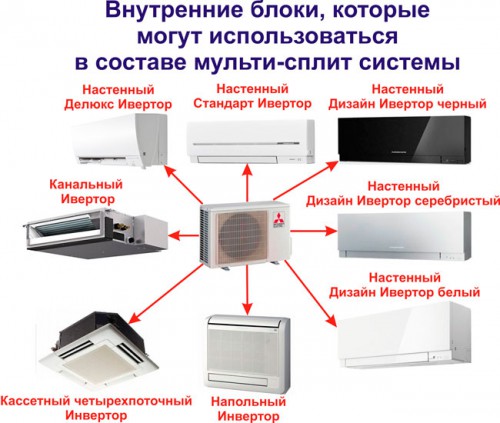
The device and the principle of operation of the air conditioner do not differ from the device of any split-system, the difference is only in specific nuances, therefore, it is very difficult to give an exact answer, which equipment best copes with the tasks set - each of them has its own disadvantages and advantages that determine the scope of their application .
Structure window air conditioners differs in a peculiar design - one part of them is inside, and another outside of the window block. With a monoblock floor option, they are similar only in construction, since all components are inside one case. The working parts - the fan and the compressor - emit more noise than the split-system, because they have these components in a separate unit located outside the room.
Before making a choice when buying such a product to your home, you need to make a comparison of the technical characteristics of the most inexpensive split systems with similar parameters of a floor or window device type - there are many positive and negative nuances for each type,therefore, it is not easy to make a final conclusion.

/rating_off.png)






